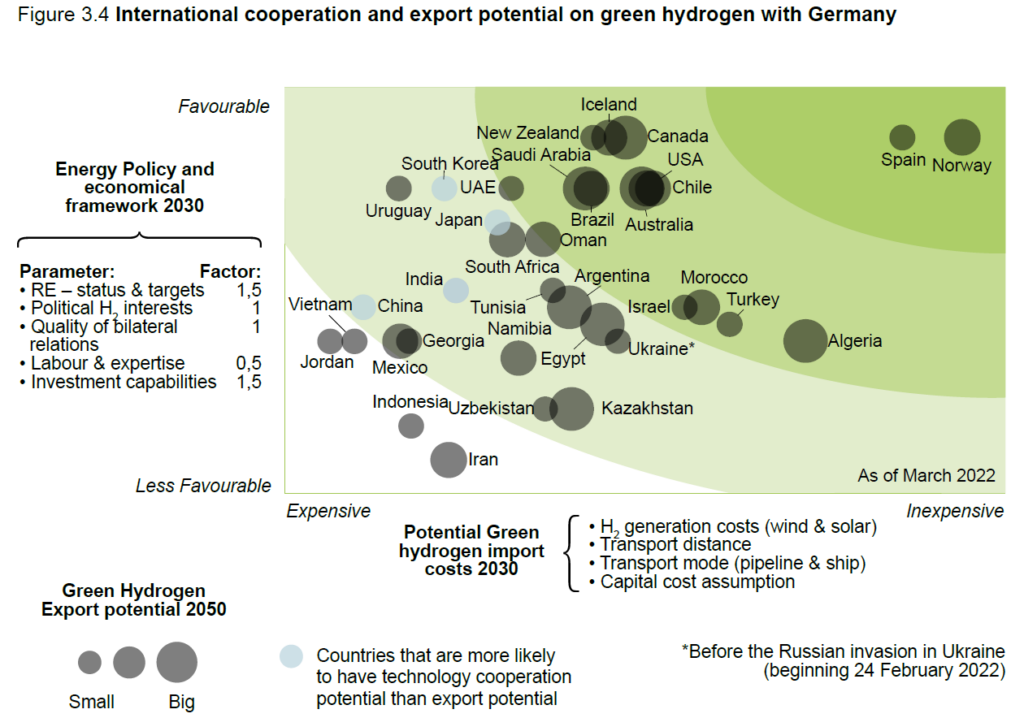New roadmap for ammonia imports into Germany
By Julian Atchison on July 14, 2022
Fortescue Future Industries leading an Australian-German business coalition

The FFI-led coalition (dubbed the Green Hydrogen Taskforce) includes Ammonia Energy notables Covestro, E.ON, Linde and thyssenkrupp. Together, the group has released a roadmap and ten-point action plan to meet ambitious ammonia import targets for Germany, including a number of policy recommendations on the EU and Australian side of the emerging supply chain.
The new report found there is a short term offtake market of 5 million tonnes per year of renewable hydrogen from German and EU industrial centers, growing to 27 million tonnes as the energy transition continues long term. Given the EU carbon price, parity between renewable and fossil-based hydrogen will come as soon as 2030, meaning that government financial support can shift to addressing the first-mover disadvantage (based on analysis from the Rocky Mountain Institute, the coalition recommends €20-30 billion in support).
Germany and the European continent are facing stagflation for the first time in years. If structured appropriately, an accelerated uptake of green hydrogen also by means of green ammonia can be a powerful economic growth driver for Germany. Our White Paper estimates that for every €1 spent as a support mechanism by Government for green hydrogen, €10 is unlocked in private investment.
FFI Chairman Dr. Andrew Forrest in his organisation’s official press release, 24 June 2022
New Guidehouse report sets out recommendations
And a new Guidehouse report has set out its own recommendations for enabling mass hydrogen imports into Germany. The report concludes that – over shorter distances – pipeline transport of hydrogen or importing renewable electricity into Germany to produce is the best form of transport. For longer distances, however:
…maritime shipping is the preferred option. Particularly for routes where hydrogen pipelines are not possible and for hydrogen derivatives, shipping can be the only transport option. However, given that converting hydrogen into derivatives (and reconversion) is the single biggest driver of transport cost, hydrogen and its derivatives should be transported in the form required by the end use to minimise conversion losses.
From Covering Germany’s green hydrogen demand: Transport options for enabling imports, Guidehouse, June 2022

And while some promising import origins are close (Spain, Norway etc.), the report also suggests many of the best options for imports are from countries that will require long distance maritime shipping (Australia, Chile, USA, Algeria, Egypt etc.). Guidehouse found that shipping ammonia not only ensures the highest possible energy content is shipped for a given vessel size, it represents the lowest emissions intensity option for transport. Cost-wise, the report showed that ammonia shipping sits in between LCOH and liquefied hydrogen.
Frans Timmermans backs ammonia maritime fuel
As reported by outlet ShippingWatch, EU Commission Executive Vice-President Frans Timmermans has backed the shipping industry to make the transition faster than expected, with ammonia to be the “future fuel”. Timmermans also commented on the newfound drive & enthusiasm he is seeing from the industry (a point also raised in our recent maritime Insights article):
I hope we can keep the transition of shipping short because shipping has a tremendous opportunity to go for clean ammonia straight away…I think ammonia will be the future fuel of the shipping industry…
I am really excited about what is happening. When I came into this position I was always grumpy about the International Maritime Organization and about shipping saying that we were asking too much and that it was impossible, but things turned a page, and it is really nice to see the enthusiasm now growing in the industry…
You are absolutely right that LNG and natural gas will be a transitional fuel, but I think we might be surprised that some shipping companies and shipbuilders will move directly to ammonia and also the production of ammonia.
Things sometimes grow exponentially, and I think in the shipping industry, which used to be arch-conservative on this point, if a number of first movers show that this is economically viable, it will move really quickly.
EU Commission Executive Vice-President Frans Timmermans quoted in “EU Commissioner confident shipping can transition quickly via green ammonia”, ShippingWatch, 4 July 2022